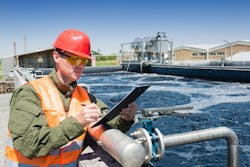Accelerating Urban Water Resilience through Innovation and Technology
While too much water is creating issues in various regions around the world, the opposite situation—prolonged drought—is also challenging water utilities in many urban areas. The issue of urban water resilience is particularly imperative because of the exponential growth of people living in these areas: according to United Nations estimates, a full 68 percent of the world’s population will be concentrated in urban centers by 2050, as compared to 55 percent in 2018.
While water and sanitation access rates are generally higher in urban areas than rural, many cities globally are facing significant challenges in managing, operating, and expanding critical infrastructure to deal with increased demand. As cities expand, particularly in less developed nations, where the growth is occurring most rapidly, planning and infrastructure are unable to keep pace, increasing the stress on the water system.
The pressing challenges of urban water management
Rising temperatures and changing precipitation patterns have further increased the complexity of water management in cities. Drought, rapid population growth, unreported water usage, short but intense periods of rainfall—these and other stresses on urban water supplies shine a spotlight on the uncertainty of water availability, reservoir/catchment levels, and even demand profiles. In fact, the BBC has reported that 11 of the world’s largest cities, including London, Moscow, Tokyo, Miami, Beijing and Istanbul—are under threat of running out of drinking water.
There are political, environmental, and economic factors at play, too. Water is impacted by both energy and transportation networks, and affected by waste management and land use practices. Water guides economic growth, and is driven by local politics. Therefore, water resource management involves a large number of important stakeholders and multiple overlapping and interconnected urban systems.
For water utilities, technical losses remain a significant issue: London’s water pipes are leaky to the tune of more than half a billion litres of water a day. In the fastest-growing city in the UK—8.8 million residents and estimated to increase by 8.8 percent before 2026—water leakage this high is not sustainable.
And water losses on the customer side add up, as well: one leaky faucet dripping at the rate of one drop per second can waste more than 3,000 gallons a year. The U.S. Environmental Protection Agency estimates that minor water leaks account for more than one trillion gallons of wasted water in the United States annually.
Bridging the gap with new infrastructure and best practices
Organizations and consortia globally have been working to define best practices in urban water resilience — and urban water capacity — for nearly a decade. Leading Utilities of the World, an initiative of the Global Water Leaders Group, is building a global network of the world’s most successful and innovative water and wastewater utilities to help drive performance across a number of innovation areas, including water resources development and drought response.
The Stockholm International Water Institute and engineering firm Arup have done considerable work since 2012 to create a city water resilience framework, methodology and approach that can be applied anywhere in the world.
In 2017, the United Nations University’s Institute for the Study of Advanced Sustainability addressed the topic, providing four policy recommendations specifically for Asian megacities, for whom urban water security is a major concern. And from 2013 to 2019, the Rockefeller Foundation pioneered the “100 Resilient Cities” organization, and continues to fund new projects to support the implementation of city resilience initiatives.
These “100 Resilient Cities” case studies are particularly informative for cities looking to establish water resiliency initiatives. As a partner in the initiative, the City of Atlanta (through its Department of Watershed Management) launched an infrastructure failure mitigation program to better address its aging infrastructure, as well as tunnelling and repurposing an old rock quarry as a new raw water reservoir, increasing the city’s water reserves from 3 days to 30 days or more.
Next-level resilience: problem-solving with technology
The first step in solving a problem is to be able to visualize it. For water utilities, this means a deep-level visualization of the entire water system, measuring flow, usage, leakage, etc., through the use of meters, IoT, and sensors in order to provide a real-time view. This visualization provides the necessary system data both to model the entire system and to identify emergent issues.
Once the system’s issues have been identified, it’s particularly important to pinpoint and prioritize the areas in which the most impact can be made to meet both short-term and long-term strategic goals. Some of these may be immediate changes, such as repairing pipes in areas in which substantial leaks have been detected, for example. Others, like larger infrastructure replacement projects, will require more extensive capital expenditures, and will therefore be longer-term goals. For both sets of goals, the use of robotics, as well as other automation and digitalization of processes, will both drive out cost (sustaining a low cost to serve) and make it easier to share data and collaborate effectively with other stakeholders and their systems. This ability to share data is imperative for the large number of stakeholders involved in a city’s water resource management efforts.
Finally, it’s really important to take a customer-centric approach when moving forward with resilience initiatives, engaging water end users with smart water usage programs that blend education with active involvement through behavioral programs. Personalized water usage insights, combined with specific savings recommendations, serve both to educate customers about their water usage and encourage water conservation and water appliance efficiency when it’s most needed to maintain system resilience.
In the end, urban water resilience can only be effective if every stakeholder and every consumer—from residential users to business and industrial users—is working toward the same, sustainable goal. The water utility is the central hub in this model, both effecting greater efficiencies in water distribution and usage and educating all of its users to equitably share the limited resource available to them.
About the Author
Kate Rowland
Kate Rowland is an industry strategist for Oracle Utilities.
